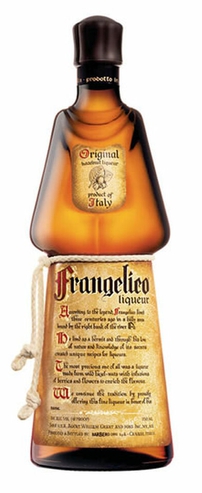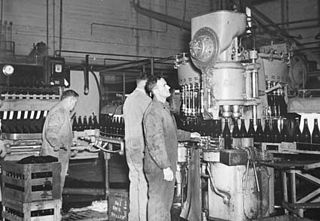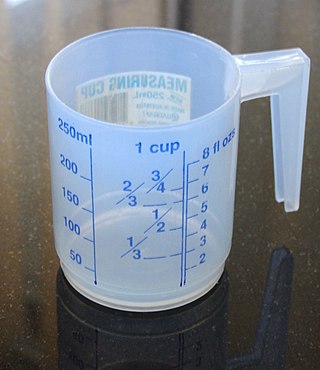
In cooking, syrup is a condiment that is a thick, viscous liquid consisting primarily of a solution of sugar in water, containing a large amount of dissolved sugars but showing little tendency to deposit crystals. In its concentrated form, its consistency is similar to that of molasses. The viscosity arises from the multiple hydrogen bonds between the dissolved sugar, which has many hydroxyl (OH) groups.
"Half and half" is the name of various beverages and foods made of an equal-parts mixture of two substances, including dairy products, alcoholic beverages, and soft drinks.

A cocktail glass is a stemmed glass with an inverted cone bowl, mainly used to serve straight-up cocktails. The term cocktail glass is often used interchangeably with martini glass, despite their differing slightly. Today, the glass is used to serve a variety of cocktails, such as the martini and its variations, Manhattan, Brandy Alexander, pisco sour, Negroni, cosmopolitan, gimlet, and the grasshopper.

A standard drink or unit of alcohol is a measure of alcohol consumption representing a fixed amount of pure alcohol. The notion is used in relation to recommendations about alcohol consumption and its relative risks to health. It helps to educate alcohol users. A hypothetical alcoholic beverage sized to one standard drink varies in volume depending on the alcohol concentration of the beverage, but it always contains the same amount of alcohol and therefore produces the same amount of drunkenness. Many government health guidelines specify low to high risk amounts in units of grams of pure alcohol per day, week, or single occasion. These government guidelines often illustrate these amounts as standard drinks of various beverages, with their serving sizes indicated. Although used for the same purpose, the definition of a standard drink varies from country to country.

The amniotic fluid is the protective liquid contained by the amniotic sac of a gravid amniote. This fluid serves as a cushion for the growing fetus, but also serves to facilitate the exchange of nutrients, water, and biochemical products between mother and fetus.

Frangelico is a brand of hazelnut and herb–flavored liqueur coloured with caramel coloring, which is produced in Canale, Italy. It is 20% alcohol by volume (ABV) or 40 proof. Formerly, it was 24% ABV or 48 proof. When produced by the Barbaro family it was bottled at 28% ABV or 56 proof. The brand was created in 1978. It is known for its unusual packaging; its bottle was designed to look like a Christian friar, complete with a knotted white cord around the waist. It is commonly sold in two sizes: 750 ml and 375 ml.

A highball glass is a glass tumbler that can contain 240 to 350 millilitres. It is used to serve highball cocktails and other mixed drinks. An example size is 7 cm (3 in) diameter by 15 cm (6 in) in height. A highball glass is taller than an Old Fashioned glass (lowball), and shorter and wider than a Collins glass.

Grapefruit juice is the juice from grapefruits. It is rich in vitamin C and ranges from sweet-tart to very sour. Variations include white grapefruit, pink grapefruit and ruby red grapefruit juice.

Beer arrived in Australia at the beginning of British colonisation. In 2004 Australia was ranked fourth internationally in per capita beer consumption, at around 110 litres per year; although, the nation ranked considerably lower in a World Health Organization report of alcohol consumption per capita of 12.2 litres. Lager is by far the most popular type of beer consumed in Australia.

TCP is a mild antiseptic, produced in France by Laboratoires Chemineau in Vouvray and sold in the United Kingdom by Omega Pharma.

The cup is a cooking measure of volume, commonly associated with cooking and serving sizes. In the US, it is traditionally equal to one-half US pint (236.6 ml). Because actual drinking cups may differ greatly from the size of this unit, standard measuring cups may be used, with a metric cup being 250 millilitres.

Beer glassware comprise vessels, today usually made of glass, designed or commonly used for serving and drinking beer. Styles of beer glasses vary in accord with national or regional traditions; legal or customary requirements regarding serving measures and fill lines; such practicalities as breakage avoidance in washing, stacking or storage; commercial promotion by breweries; artistic or cultural expression in folk art or as novelty items or usage in drinking games; or to complement, to enhance, or to otherwise affect a particular type of beer's temperature, appearance and aroma, as in the case of its head. Drinking vessels intended for beer are made from a variety of materials other than glass, including pottery, pewter, and wood.

"Splice the mainbrace" is an order given aboard naval vessels to issue the crew with an alcoholic drink. Originally an order for one of the most difficult emergency repair jobs aboard a sailing ship, it became a euphemism for authorized celebratory drinking afterward, and then the name of an order to grant the crew an extra ration of rum or grog.

Caffè americano, also known as americano or American, is a type of coffee drink prepared by diluting an espresso shot with hot water at a 1:3 to 1:4 ratio, resulting in a drink that retains the complex flavors of espresso, but in a lighter way. Its strength varies with the number of shots of espresso and the amount of water added. The name is also spelled with varying capitalization and use of diacritics: e.g., "café americano".
A case of some merchandise is a collection of items packaged together. A case is not a strict unit of measure. For consumer foodstuff such as canned goods, soda, cereal, and such, a case is typically 24 items, however cases may consist of any quantity depending on manufacturer packaging - cases are typically found in multiples of 4 or 6. For larger bottles such as gallon jugs, a case is typically 4.
A whisky Macdonald, more commonly known under the shortened name whisky Mac, is a cocktail made up of whisky and ginger wine. The whisky is expected to be a Scotch whisky, usually a blended type. The ginger wine should be green ginger wine. Recipes vary from those having equal parts of each ingredient to those that use a ratio of 3 to 2 of whisky to wine.
Caffè crema refers to two different coffee drinks:

A growler (US) is a glass, ceramic, or stainless steel bottle used to transport draft beer. They are commonly sold at breweries and brewpubs as a means to sell take-out craft beer. Rarely, beers are bottled in growlers for retail sale. The significant growth of craft breweries and the growing popularity of home brewing has also led to an emerging market for the sale of collectible growlers. Some U.S. grocery stores, convenience stores, bars and restaurants have growler filling stations.

Pine needle tea or pine leaf tea is a herbal tea made from pine needles, or the leaves of pine trees. In Korea, the tea made from the leaves of Korean red pine or Manchurian red pine is known as solip-cha (솔잎차), while the tea made from the leaves of Korean pine is known as jannip-cha (잣잎차) or baek yeop-Cha. In North America, pine needle tea may be made from the leaves of Eastern white pine and Loblolly, Virginia Pine, Long Leaf Pine.















